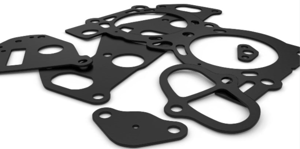Have you ever chosen a gasket adhesive?
Not all gaskets require adhesives, but they can help gaskets perform more efficiently in certain circumstances. Finding gasket adhesives in these cases can be a crucial step in the design process, but many people don’t know where to start.
At Strouse, we’re used to working with adhesive gasket material to help our customers build the most efficient sealing solutions. Designing an effective gasket relies on the compatibility of the materials and the design.
This gasket adhesive overview will help you achieve the best sealing design functionality,
WHY USE GASKET ADHESIVES?
As you may already know, gaskets create a pressure-tight seal between two surfaces, preventing fluid escape and contamination. They can also provide insulation, cushioning, and noise reduction.
Gasket adhesives are used for designs needing tighter, even more reliable bonds between surfaces.
Your choice of gasket material or adhesive will depend on factors such as temperature range, pressure range, exposure to corrosives or UV radiation, and industry-specific requirements. Today, we’ll review types of adhesive gaskets to help you find an adhesive that suits your material and design.
The Best Adhesive Types for Gaskets
Since there are hundreds of adhesive variations, we’ve sorted the best gasket adhesives into different categories.
As we review the different types of gasket adhesives, remember that choosing the right one depends on your application and design.
1. PRESSURE SENSITIVE ADHESIVES (PSAs)
Pressure-sensitive adhesive (PSA) tape is cost-effective, easy to use, and can be converted into custom sizes and shapes. PSAs typically come in three formulations that match various gasket materials: acrylic, silicone, and rubber-based adhesives.
Most available acrylic, silicone, and rubber gaskets are sold and shipped with a pressure-sensitive adhesive backing. These “peel and stick” gaskets feature double-sided backings, with the release liner remaining in place until the gasket is installed.
a. ACRYLIC BASED
Operating temperature range: -50°F (-46°C) to 350°F (177°C).
Acrylics naturally soften when exposed to heat and harden when cooled, offering a wide temperature range. This allows acrylics to flow under light pressure and adhere to most gasketing materials and surfaces, which is vital when bonding to irregular or rough surfaces.
b. SILICONE BASED
Operating temperature range: -80°F (-62°C) to 450°F (232°C).
Silicone-based adhesives adhere well to most surfaces, best to silicone elastomers, yet are also the highest cost. They also offer the broadest operating temperature range
However, the holding power may not be high enough for non-silicone applications. Standard silicone sealants require a 2 to 24-hour curing time (anaerobic sealants cure in about an hour). Without curing, the seal’s integrity can be compromised.
c. RUBBER BASED
Operating temperature range: 50°F (10°C) to 150°F (66°C).
Usually available at a lower cost (with lower performance), a rubber-based adhesive is a general-use adhesive that works best on aluminum, bare metal, stainless steel, and non-polar substrates: polyolefins, EPDMs, and silicones.
1a. TYPES OF PSAs
Within PSAs, the three main types of tape are adhesive transfer, double-sided, and foam tape, with the most common being VHB.
Each adhesive type offers advantages depending on the project’s purpose, but all three can be pre-applied to gasketing material before it’s cut into custom parts.
i. ADHESIVE TRANSFER TAPE
With high conformability, initial adhesion, and overall strength, adhesive transfer tape’s liner stays on the gasket until the second substrate is ready. Depending on the exact gasket performance demands, these are the important advantages:
- Flexibility — Thin (sub one mil) and conformable; bonds to irregular shapes and sizes
- No Carrier — Not limited to the temperature resistance of a carrier
- Low Profile — Easily stacked atop one another if needed
Suppose an optional priming solution is used to help the adhesive transfer tape stick to the gasketing material. In that case, these gaskets should be used within a year without a priming solution (note: transportation and storage conditions can affect shelf-life).
ii. DOUBLE SIDED TAPE
A carrier within double-sided tape enables the bonding of two similar or completely different substrates (perfect for gaskets). It also provides stability, making the tape more manageable to handle and convert. The carrier’s material may be paper, plastic, foam, or film—depending on what the gasket needs to do—thicknesses can range from a fraction of a millimeter to a thick foam.
iii. VHB TAPES
3M VHB™ tapes are heavy-duty double-sided foam tapes made from high-performance acrylic adhesives.
VHB tape can contour to various shapes, including gaskets. In fact, some VHB tapes are strong enough to replace rubber or foam gaskets because their closed-cell construction creates a watertight barrier between two flat parts. Like transfer and double-sided tape, VHB tapes can be cut into custom shapes by a flexible material converter.
3. LIQUID ADHESIVES
Because spray and liquid adhesives can be messy, they require specialized application processes.
Liquid adhesives are powerful but can be challenging to apply, whether using an automated machine or manually. Also, the adhesive’s curing time (which can usually reach handling strength in 5-30 seconds) could slow gasket processing.
Liquid adhesives, commonly used on rubbers and plastics, come in handy for tight spaces, although they’re more expensive, and dripping glue requires clean-up after application.
2. SPRAY ADHESIVES
Both solvent- and water-based adhesives can be sprayed (or applied with a brush or roll).
Spray adhesives are fast to apply, economical, and can cover irregular shapes. Unfortunately, it can be challenging to achieve an even application for spray adhesives, even when using a specialized applicator, which might cause quality concerns.
In some specialized applications, one-part anaerobic liquid adhesives can be applied between complex metal shapes and cured, completely replacing preformed gaskets.
HOW DO YOU FIND THE RIGHT GASKET ADHESIVE?
Although we’ve suggested three adhesive types, choosing the right gasket adhesive isn’t as simple as picking one of the options. Every type of adhesive has hundreds of products on the market, and pricing varies between suppliers.
So, how can you ensure you receive the most suitable adhesive at the right cost? Remember that you’re not simply choosing an adhesive type, but also how that adhesive is used.
Working with an experienced partner, such as a flexible material converter, will allow you to prepare for a successful product application.
Before you invest everything into one material or drawing, why not test your gasket design to see how it functions?
Accurate prototypes allow you to perform tests to finalize your material selection and tolerances. If you’re interested in receiving accurate samples based on your drawing, reach out to us to get started.
Not quite ready to begin testing? In that case, consider reading about the cost of custom gasketing to learn more.
Originally published: May 27, 2021







